Are you looking for some savvy pea gravel landscaping ideas to give your backyard a makeover? If so, you’ve come to the right place! In this post, we’ll explore the aesthetic and practical benefits of using pea gravel and share some creative tips on how you can use it to transform your outdoor space. Ready to get started? Let’s dive into our guide!
What is Pea Gravel?
Pea gravel is one of the most popular types of landscaping materials used for making pathways, driveways, and garden borders. It’s a great choice because it’s affordable, easy to install, and comes in various colors and sizes.
This size makes gravel perfect for creating drainage paths and areas where you don’t want water to pool up.What is Pea Gravel Used For?
Pea gravel is a type of small, rounded rock that has a variety of uses in landscaping and construction. It can be used to create pathways, fill driveways, line beds and as edging near water features. Pea gravel comes in a range of sizes from fine pebbles to larger stones. The size you choose depends on the effect you are trying to achieve with your landscape design.

With its attractive color and texture, gravel can be used in various ways to add character and charm to any outdoor space.
Pros of Pea Gravel
Pea gravel is an excellent choice due to its affordability, durability, and wide range of colors and sizes. It can be used in a variety of ways to enhance your outdoor living space including pathways, driveways, edging borders, walkways, play areas — even as a decorative centerpiece in gardens or water features. Pea gravel is also easy to install and can be done so with minimal effort. As opposed to other materials such as concrete pavers or stone slabs, pea gravel requires less maintenance since it does not require the same level of care when it comes to weed control or resealing. Additionally, using it eliminates the need for any digging or heavy equipment necessary for installation.
Overall, the biggest advantage of pea gravel is its versatility — it can be used in any type of outdoor space and will achieve the desired look with minimal effort. From adding texture to your garden beds or creating an eye-catching border around a patio, there are endless possibilities with pea gravel! With just a few simple steps, you can transform your outdoor space into one that’s both beautiful and functional.
Cons of Pea Gravel
One of the major cons of using pea as part of your landscape design is that it can be difficult to up once it’s been put down. The stones are heavy and shifting them from one area to another can take quite a bit of effort. Another caveat associated with pea gravel is its tendency to easily become overrun by weeds and other invasive plants if not properly treated. As with any landscaping project, proper preparation is essential for success – so make sure you’re familiar with all aspects of stone care before beginning. Finally, because pea gravel works best in well-draining soils, it’s not ideal for wet or damp areas. Areas that are prone to flooding might be better served by another material, such as mulch.
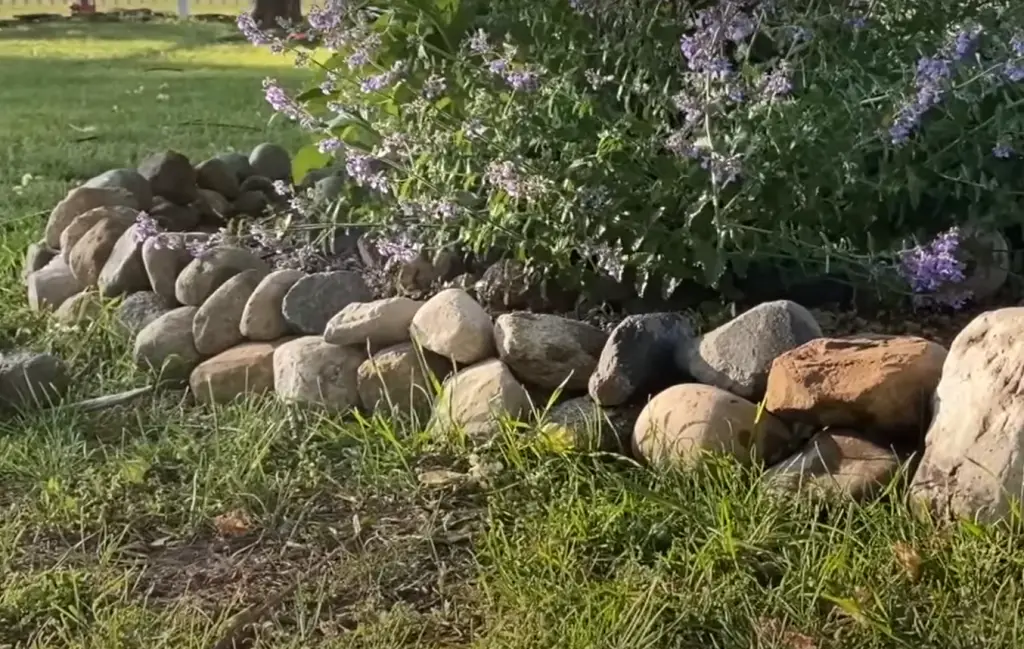
These minor considerations aside, pea gravel remains a popular choice among landscapers and homeowners alike due to its versatility, affordability, and ease of installation and maintenance. If you think that pea gravel could be the right fit for your landscaping project, give it a try – you won’t be disappointed!
How to Install Pea Gravel
Installing pea gravel is an easy and affordable way to give your landscape a new look. The best way to install it is by laying down a layer of landscape fabric or plastic sheeting.
Once the layer of fabric has been installed, you can spread the pea gravel over it evenly and in the desired pattern. If you would like to create a more decorative look, you can use edging material such as plastic bricks or wood logs to outline the area where the gravel will be placed. This will also help keep it from spreading into other areas of your yard or garden.
After everything is in place, use a rake to spread and level the gravel so that it is even across the surface. Next, you will need to compact the gravel by walking over it with a heavy roller or plate compactor. This will help ensure that the stones stay in place and won’t move when walked on. [1]
Finally, you can use a garden hose to spray down the area and wash away any excess dirt and dust.
Pea Gravel Patio Ideas
Pea gravel is perhaps the most versatile of all landscaping materials. It can be used to create a stunning patio that your family and friends will love. Here are some ideas for you to consider:
- Create an intimate seating area with a variety of colors and sizes. Pea gravel comes in diverse shades, from warm hues like pink and yellow to cool blues and greens. You can also find it in various sizes, from small pebbles to larger stones. Mix things up by using both large and small pieces in your design for added texture.
- Include some plants around the edges of your patio for visual interest and additional privacy. This could include fragrant flowering shrubs, evergreen bushes, or even tall trees.
- To create a luxurious look, consider adding some large flagstone pavers around the edges of your patio. This will provide a nice contrast to the pea gravel while also giving you more options for seating and design elements.
- If you like furniture on your patio, try using wood pieces that coordinate with the color of your pea gravel. This will help to tie everything together nicely and give your space an eclectic feel.
- A fire pit can be a great addition to any patio, especially when made out of pea gravel. The gravel can hold quite a bit of heat and has beautiful reflective qualities in the light. You can easily build a fire pit out of pea gravel, or purchase a pre-made one from your local home improvement store.
Between Raised Beds
One of the most common uses for pea gravel is to fill in raised beds and walkways. Pea gravel can be used as a way to make your garden look more attractive, while also providing a durable surface that will not erode or break down over time. To create an attractive walkway, you can lay out pea gravel in a pattern on top of the soil or use an edging material such as bricks or stones along the edges.

If you are using a raised bed design, then layer the ground with several inches of pea gravel before adding soil and plantings. This will prevent weeds from growing up through the bottom of your bed and make it easier to maintain. Pea gravel also helps keep moisture levels consistent and can provide a beautiful accent if you choose to use different colors.
Garden Walkways
A great way to make use of pea gravel in your lawn is to create garden walkways. Not only will this add a layer of beauty to your landscaping, but it can also help prevent damage to your plants and yard since you will be able to control the path that people take when they are walking through your lawn.
Then fill the trench with at least two inches of crushed stone or pea gravel. Once this is done, use landscape fabric overtop the gravel before adding an additional layer of stones for added stability and aesthetic appeal. This will ensure that the pea gravel does not get washed away during heavy rains. Finally, use a broom or rake to smooth out the surface and make it look neat. Now you have a beautiful garden walkway that offers practical protection for your lawn as well!Garden Bench On Pea Gravel
A garden bench on a bed of pea gravel can be an inviting spot to relax and enjoy the beauty of your landscaping. To create this look, use a raised planter box as the base for your garden bench. Fill it with several inches of pea gravel, then place the bench in the center. For additional comfort and style, add some cushions or decorative pillows. This is a great way to make a statement piece out of your pea gravel design without taking up too much space.
Garden Shed On Pea Gravel
If you’re looking for a unique and visually appealing way to house your garden tools, consider creating a garden shed on pea gravel. This project can be as simple or complex as you like, depending upon the size of the structure and your budget. To start off, choose whether you would like to construct a wooden, metal or plastic shed. Once it has been built, lay down a bed of pea gravel underneath it.

This will help create drainage and keep standing water from accumulating around the bottom of the shed which could lead to rot and other damage. The pea gravel also adds an interesting natural element to your yard that can easily be customized with plants, rocks or any other type of decorative material. Finally, enjoy all of your hard work! Your pea gravel garden shed is sure to become the envy of your neighborhood.
Greenhouse Flooring
If you love gardening and have a greenhouse, then pea gravel is the perfect solution for your flooring. Not only does it provide an excellent base for your plants and flowers, it also adds to the overall beauty of the space. Pea gravel helps keep weeds away, absorbs moisture and water, prevents soil erosion, and helps regulate temperature. To make sure that your greenhouse is in top condition, you can use a quality weed-control fabric underneath the pea gravel. This will help protect against anything that may try to grow through from below. Additionally, if you want to give your greenhouse an attractive look, consider adding colored stones or small stones around the edges of the pea gravel area — it will add a nice touch!
Flower Bed Ideas
When it comes to flower bed ideas, pea gravel is a great choice for an attractive and low-maintenance garden. The small stones are easy to spread around the edges of your flower beds without needing any special tools or equipment. Pea gravel can also be used as mulch in between plants, helping retain moisture and keep weeds down. If you want to add some extra color to your flower beds, mix in a few colored pebbles for a unique look! You’ll be surprised how much visual appeal this simple material can bring to your outdoor space.
Pea gravel is also ideal for walkways and pathways leading up to your garden or home. Create a winding pathway lined with smooth, natural-looking stones that will provide a pleasant walking experience and an inviting entrance to your garden. The pea gravel also helps keep weeds from growing between the stones, making it easier for you to maintain your paths without needing any additional products or treatments.
When using pea gravel for landscaping, be sure to choose a type that is weed-free and resistant to fading over time. You can find various colors of pea gravel at most home improvement stores, so make sure to pick the type that best fits with your flower beds and other landscaping elements. With proper installation and maintenance, pea gravel can create a beautiful and unique look for your outdoor space!
Around Trees
When landscaping around trees, it is important to keep the roots of the tree safe and undisturbed. Pea gravel can be used as a mulch substitute in these cases. It will provide a protective layer around the tree, helping to keep out unwanted weeds and grass that may compete with the tree for nutrients. Additionally, pea gravel helps retain moisture in the soil for healthier root growth without allowing water or other materials to become trapped and cause disease.
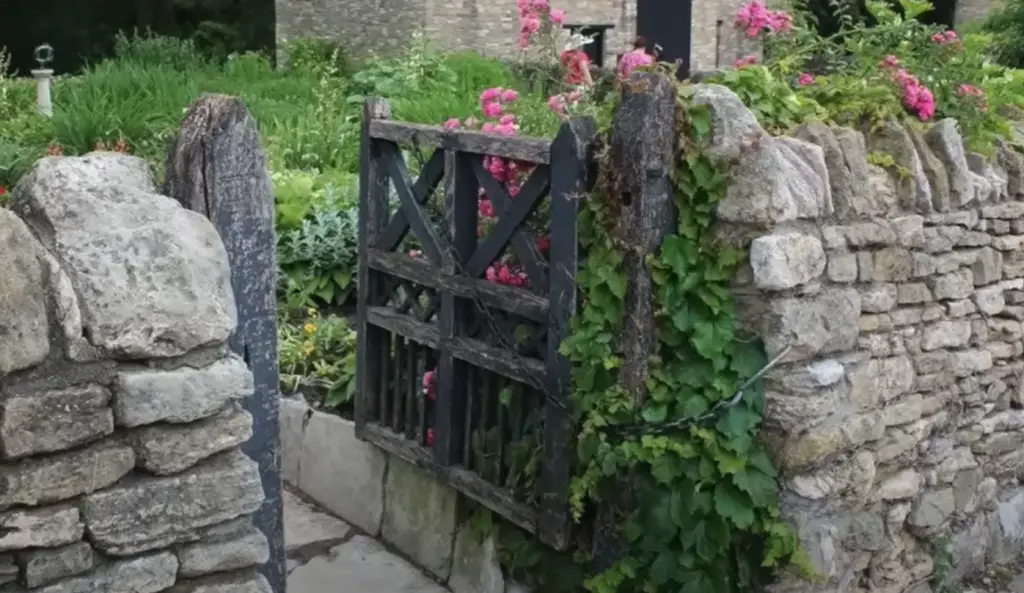
Another use is to create a pathway or walkway among trees, providing an easy-to-maintain option for getting around your garden or yard. Choose a different color of pea gravel than you did when creating beds – this will make it more obvious that it is a pathway. The pea gravel will create a lovely crunching sound beneath your feet and make it easier for you to walk around the trees without fear of damaged roots or soil erosion.
Finally, adding some pea gravel around the base of each tree can help protect it from lawn mowers and other equipment that may damage bark and cause infection or decay in the tree. Additionally, if you have children or pets who like to play rough outdoors, this can also provide protection against their activities well.
Around Shrubs
Using pea gravel around shrubs, trees and plants is a great way to keep their roots from becoming waterlogged. By creating a slight slope around them, the water will run off away from the base of the tree or plant. It also helps to better define your planting areas which makes for more appealing garden beds.
Another option is to use pea gravel as mulch in place of regular bark chips or wood shavings. Pea gravel has excellent drainage properties so it helps keep the soil moist while keeping disease-causing fungi at bay. The small size also prevents weeds from taking hold and allows air to circulate freely around the roots for healthy growth.
If you’re looking for a bit of color, you can even find pea gravel in different hues so it’s possible to create an eye-catching design. The main idea is to provide these areas with enough drainage so water doesn’t accumulate and damage plants.
Creating a path or walkway around your shrubs and trees gives them a more finished look and also helps keep people from trampling the area. A border of stones or pavers lines the edge nicely while pea gravel fills in any remaining space. It’s important to ensure there’s an adequate slope away from the shrub so that water runs off quickly.
Pea gravel creates a pleasant, natural-looking setting for your outdoor plants and shrubs. It’s one of the most versatile landscaping materials and can be used in many different ways to enhance your garden beds. With a bit of creativity, you’ll have an attractive landscape design that will last for years to come!
Pea Gravel With Succulents
One of the most popular pea gravel landscaping ideas is to use it to create a unique and visually appealing feature. This can be done by combining pea gravel with succulents, as they are both great options for adding texture, color, and visual interest to an outdoor space. The combination of these two materials creates a natural-looking landscape design that will help you stand out from the crowd. To make this look even more attractive, consider mixing different sizes of pea gravel for added texture and dimension. You can also experiment with various shapes and colors of succulents to create your own unique design that really pops!
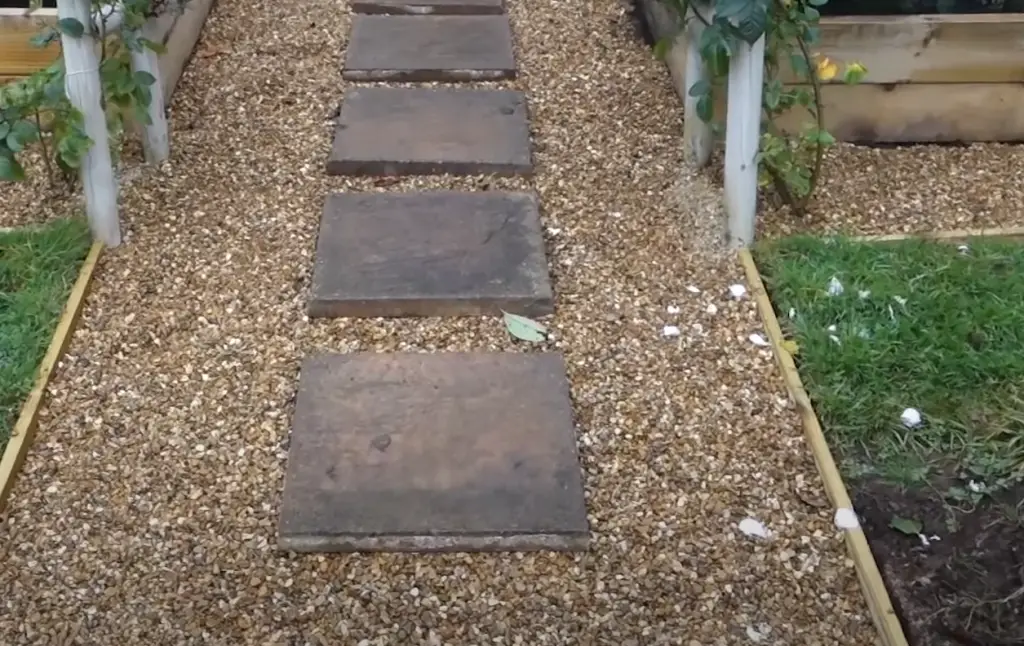
For optimal results, ensure that the pea gravel is flat against the soil so that water does not pool in one spot. Additionally, succulents do best when planted in well-drained soil, so be sure to check the drainage before planting. With a little creativity and some careful planning, you can create a stunning outdoor feature with pea gravel and succulents!
Pea Gravel With Cacti
Cacti can add an interesting and unique look to a pea gravel landscape. The pea gravel will make it easier to keep the cacti watered, as water may not be able to penetrate the soil when there’s too much clay or packed dirt. You’ll want to space the cacti out slightly so that they are surrounded by pea gravel but still have enough room to spread out their roots. When planting your cactus in the middle of the pea gravel, you should dig a hole for them, mix some soil into the bottom of it, and then fill in around it with more pea gravel. This method will ensure that your cactus has enough soil and nutrients to thrive while also protecting it from the elements. Additionally, you could add some larger pea gravel around the base of the cactus to further protect its roots and help retain moisture in the soil.
You can also create beautiful paths with pea gravel and cacti by lining pathways with small succulents like Aloe Vera. This will provide a lush walkway while allowing you to maintain a low-maintenance landscape. You can also use this method to line driveway edges or garden beds for a unique aesthetic that won’t require much upkeep once planted.
For added flair, you can pair your cacti and succulents with colorful stones like obsidian or turquoise for an eye-catching contrast against the muted tones of the pea gravel. This will bring an even more unique and beautiful look to your landscape that’s sure to be a conversation starter with guests.
Pea Gravel With Potted Plants
Using potted plants with pea gravel is a great way to add texture and color to your landscape. You can mix different types of gravel together – like white, grey or black pea gravel – and accent it with colorful flowers in pots. This gives your garden an eye-catching contrast while still keeping things looking natural. Plus, you don’t need to worry about the plants requiring too much maintenance as they are already contained in their own little pots!
Zen Garden
If you want to create a peaceful oasis in your backyard, consider building a Zen garden with pea gravel. A Zen garden is designed to be soothing and tranquil, often without any plants or other decorations. The best way to achieve this look is with a few large stones arranged in an attractive pattern, surrounded by pea gravel. You can also add small stones or rocks to the design for extra texture and detail.
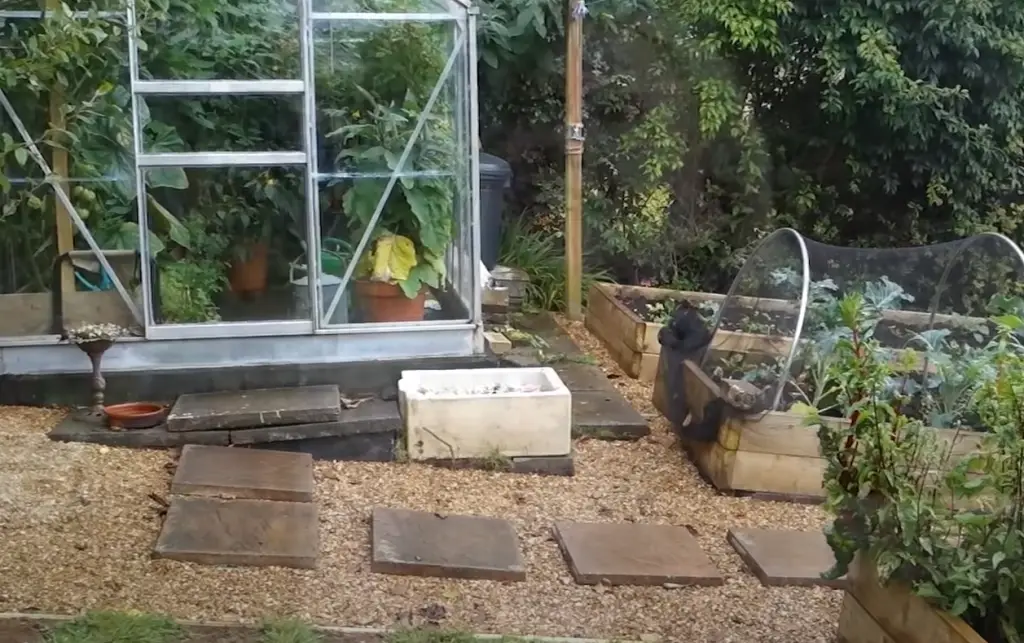
Pea gravel is available in a variety of colors, so you can choose one that makes your zen space feel even more serene and relaxing. With just a few tools and supplies, you’ll be able to enjoy your own private escape from reality!
Under Bird Bath
If you love attracting birds to your garden, a pea gravel bed is the perfect place for bird baths and feeders. Create an area of clean, smooth pea gravel to provide a safe and comfortable landing spot, as well as a great place for birds to feed. You can also add in stones or plants to create more texture. If you want to keep the area tidy, consider adding edging around the bird bath or feeder. This will help contain the pea gravel and make it easier to sweep up any debris that falls into the bed. Additionally, when choosing your bird bath or feeder, look for models with wide bases so they won’t topple over easily in windy conditions.
Garden Terraces
Garden terraces are a great way to add character and charm to your outdoor space. Pea gravel is the perfect material for creating gorgeous, eye-catching garden terrace designs that you can enjoy in any season. To create a garden terrace with pea gravel, start by laying down a layer of coarse sand or crushed stone as the base. Once this is done, spread the pea gravel over the area and work it into place using a rake. You can shape the stones into the design you desire – from winding paths to simple rectangles – to give your garden terrace an elegant and unique look. With its natural colors of browns, grays and blues, pea gravel can be used to create stunning visual effects that will make your outdoor space stand out. Finally, you can add a border of stones or wood around the terrace to define its edges and complete the look.
Pea Gravel Stairs
Pea gravel is a great material for creating interesting and inviting stairs. It’s lightweight so it won’t weigh down the structure, and its round shape makes it easy to create even steps. Just be sure that you use enough pea gravel to keep your stairs stable, especially if they will be used often. You can also add other materials like stone or brick accents to enhance the design of your stairs. Pea gravel can also be used to create pathways leading up to the stairway, which adds an extra layer of texture and interest to the landscape. With just a few simple additions, you can have a beautiful staircase in no time! [2]
Mix gravel with drought-resistant plants
If your garden is in a sunny, dry area and you’re looking for ways to add color without spending too much on regular maintenance, mix some gravel with drought-resistant plants. This combination will create an attractive landscape that requires little attention. You can find a variety of desert-friendly shrubs, succulents, and cacti that look great when planted near pea gravel. Be sure to pick the right kind of gravel size; it should not be so big as to make walking around difficult but also not so small as to get lost amongst the plantings.
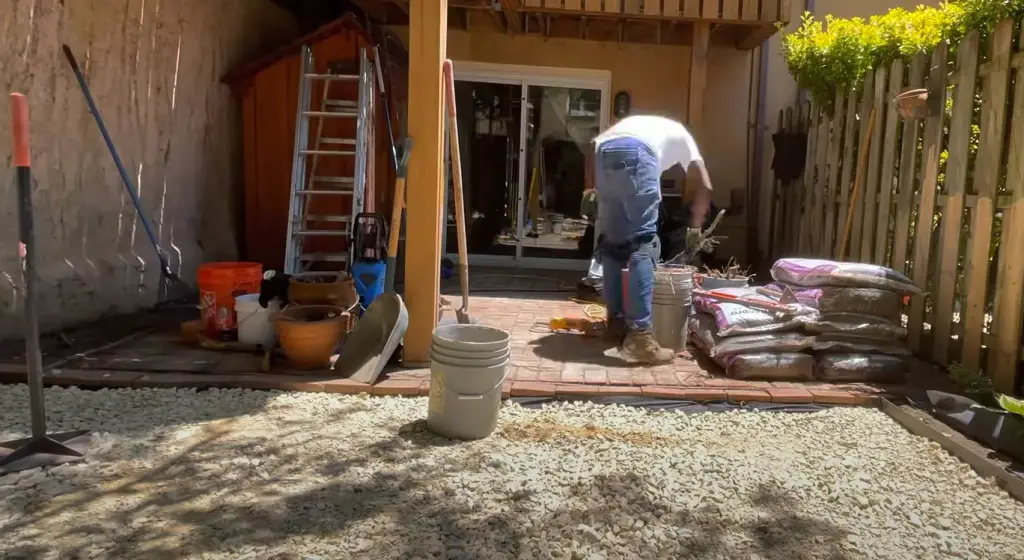
Once everything is set up, the only thing left to do is enjoy your new low-maintenance backyard! With minimal effort, you’ll have a beautiful and inviting outdoor space that requires very little effort to keep it looking great. Plus, the added benefit of pea gravel is that it helps reduce water runoff and minimize erosion, making your garden a more sustainable option. So go ahead and try out some pea gravel landscaping ideas – you won’t regret it!
The key is to remember that landscape design with pea gravel isn’t just about choosing the right kind of stone. It also involves thinking about how best to mix plants, trees, soil and other elements for a picture-perfect end result! With some patience and creativity, you can create an amazing outdoor oasis using pea gravel.
Gravel around the water feature
Using pea gravel as a border around your water feature can add an extra dimension of sophistication to it. The pebbles can be arranged in different patterns, such as concentric circles or random shapes, to create a unique look. Adding lighting to the area will further enhance its beauty. It is best to use larger stones for this purpose, as they will remain set in place better and be less prone to displacement by strong winds or heavy rains.
Japanese-style raked gravel
One of the most popular pea gravel landscaping ideas is to create an aesthetic Japanese-style look. This involves creating raked patterns with your pea gravel and takes a bit of practice and patience, but it’s worth it when you see the results! You can also use other materials like moss or stones to add texture and color. To get started, you will need to decide how large of an area you would like to cover and what pattern you would like to make. Then, using a rake or trowel, carefully arrange your pea gravel into whatever shape or design you have chosen. Raking your pea gravel should be done on a regular basis in order to maintain the desired pattern. With this method of landscaping, you can create a calming, peaceful atmosphere in your own backyard.
Segmented gravel designs
Sleek, modern designs can be achieved by combining pea gravel with larger stones. This combination adds texture to the garden and makes it look more interesting. To create this design, use a shallow trench as a border and fill it in with the desired sized gravels. The contrast between the small pea gravel and larger stones gives an eye-catching touch to your landscaping project. You can also add plants or flowers to complete the look. [3]
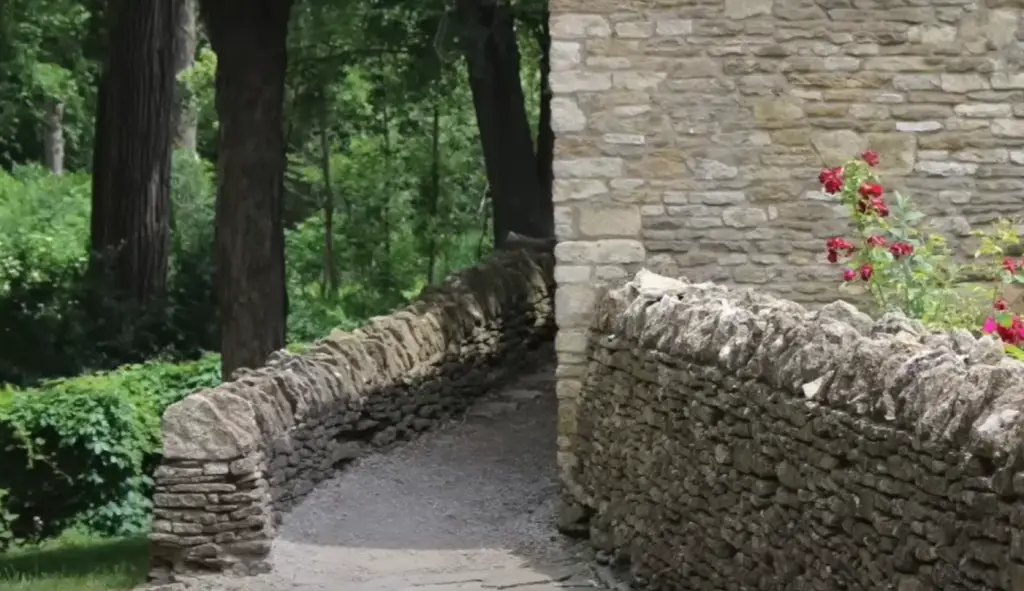
Another option is to use a mix of different sizes of pea gravel for a more subtle effect. Mixing small, medium, and large pea gravel can create patterns or textures that make the landscape stand out from other similar spaces. Since there are no hard edges in this design, the pea gravel can take on the shape of whatever it is placed in. Therefore, this type of design works great for creating unique shapes and designs with your landscaping.
Is Pea Gravel Good For Patios?
Pea gravel is a great material for patios! It’s affordable, easy to work with, and can provide a unique look to your outdoor space. Plus, it’s low maintenance, which means you won’t have to worry about regular upkeep like you would with other materials.
When it comes to patio installation, pea gravel is a great choice. It can be easily spread over the entire area of the patio and then compressed using a plate compactor or roller. This creates an even surface that will last for years without needing any further attention. The natural look of pea gravel also lends itself well to different design elements – from rustic charm to modern sophistication.
The downside of pea gravel is that it can be difficult to keep clean. Leaves and debris can easily get caught in the stones and may require regular sweeping or vacuuming. However, this is a minor inconvenience that won’t take away from the aesthetic of your patio.
So if you’re looking for an affordable material with great versatility, low maintenance requirements, and unique character, pea gravel might be just what you’re looking for! With a little bit of effort, you can create a beautiful outdoor space that will last for years to come.
FAQ
What do you put down under pea gravel?
The best thing you can put down under pea gravel is a layer of fabric. This will help keep the rocks in place and prevent them from sinking into the soil over time. You could also add a thin layer of sand or crushed rock on top to further assist with drainage, but this isn’t always necessary. If you’re using larger stones, such as river rocks, adding a small amount of landscape adhesive to hold them in place may be beneficial. Additionally, if your area tends to be more prone to erosion, consider putting in some edging around the perimeter of your pea gravel landscaping area for extra stabilization. [4]
What are the disadvantages of pea gravel?
Despite all the benefits of pea gravel, there are a few drawbacks to consider. Pea gravel is great for low-traffic areas like walkways and gardens but it can be easily kicked up when walked on. This could become a tripping hazard in certain cases. Additionally, because it’s so small, it can also get into grass or flower beds and make them look messy if not properly contained with edging materials. Finally, due to its smaller size, weeds can quickly grow through the gaps and spread throughout your yard. All these issues can be avoided by proper planning and maintenance of your pea gravel landscaping design. For more information on how to maintain your pea gravel garden and avoid common pitfalls, please check out our other articles.
Why not use pea gravel?
Pea gravel is a versatile landscaping material that is easy to work with and affordable. It can be used in many different applications, from walkways to driveways. Pea gravel is available in a range of colors and sizes, making it the perfect choice for any project. Its small size makes it gentle on feet and paws, while its relatively low cost makes it accessible to most homeowners. Additionally, pea gravel requires little maintenance once it’s installed and won’t need any specialty tools or supplies like other materials might require.
Not only does pea gravel look great when used for landscape design but it’s also environmentally friendly. Unlike asphalt or concrete, pea gravel doesn’t require energy-intensive construction, so it won’t have an adverse effect on the environment. Plus, because it doesn’t contain any chemicals or other additives, pea gravel is non-toxic and safe for pets and children.
Do you need to lay anything under pea gravel?
When considering pea gravel landscaping, it is important to think about what type of material should be used as a base. Depending on the size and type of pea gravel you are using, you may need to lay crushed stone or sand under it. This layer of aggregate helps keep the pea gravel in place for longer, reducing the amount of raking required over time. If you have an area that is prone to heavy rains or flooding then laying a thicker layer of aggregate can help reduce erosion problems. It is also important that the soil underneath is properly compacted before adding layers of stone or sand. Doing so will help create a stable foundation that won’t shift when exposed to moisture and pressure.
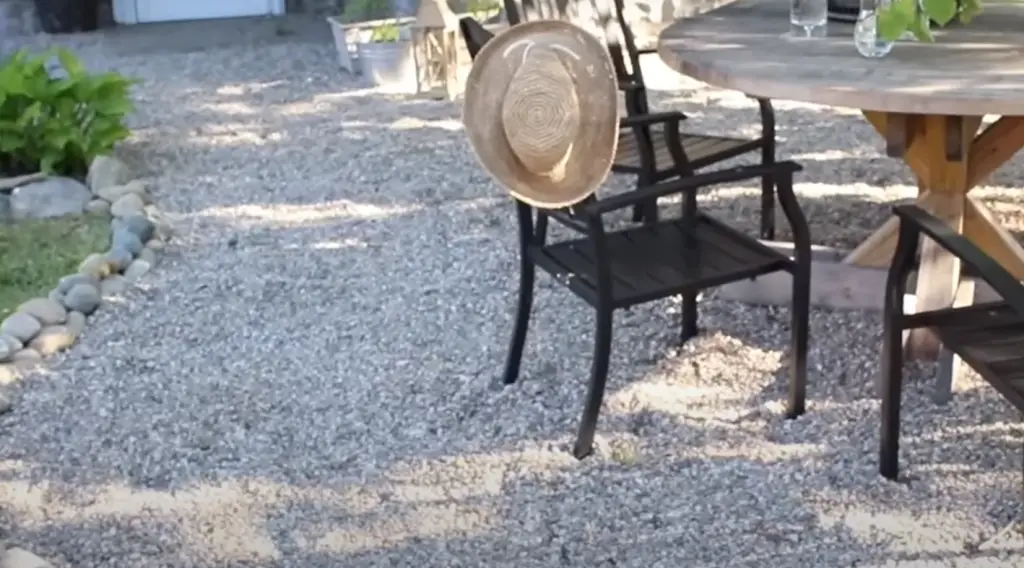
Another option to consider is using landscaping fabric just before laying the gravel. This fabric helps keep weeds from growing through and also prevents soil from mixing with the pea gravel, keeping it looking neat and tidy. Make sure to secure the edges of the fabric to stop them from curling up over time. [5]
With all types of landscaping projects, preparation is key in ensuring you have a successful outcome. Taking your time when considering what type of base material should be used under pea gravel will help make sure that your finished project looks great and lasts for years to come!
Useful Video: Easy DIY Pea Gravel Patio
Conclusion
Pea gravel landscaping is an attractive, easy-to-maintain option for adding texture and color to your outdoor space. When used correctly, it can provide a unique and beautiful look to your garden or yard. It also requires minimal maintenance, which makes it a great choice for busy homeowners who don’t have the time to dedicate to complicated projects. With the right design ideas in mind and a little bit of planning, you can create stunning pea gravel landscape designs that will be the envy of your neighbors! So why not get started today? Good luck!
References:
- https://www.lawnstarter.com/blog/landscaping/how-to-landscape-with-pea-gravel/
- https://freshpatio.com/pea-gravel-garden-ideas/
- https://edenapp.com/blog/best-pea-gravel-landscaping-ideas-for-2022/
- https://www.lawnstarter.com/blog/landscaping/how-to-landscape-with-pea-gravel/
- https://www.lowes.com/n/how-to/diy-pea-gravel-patio





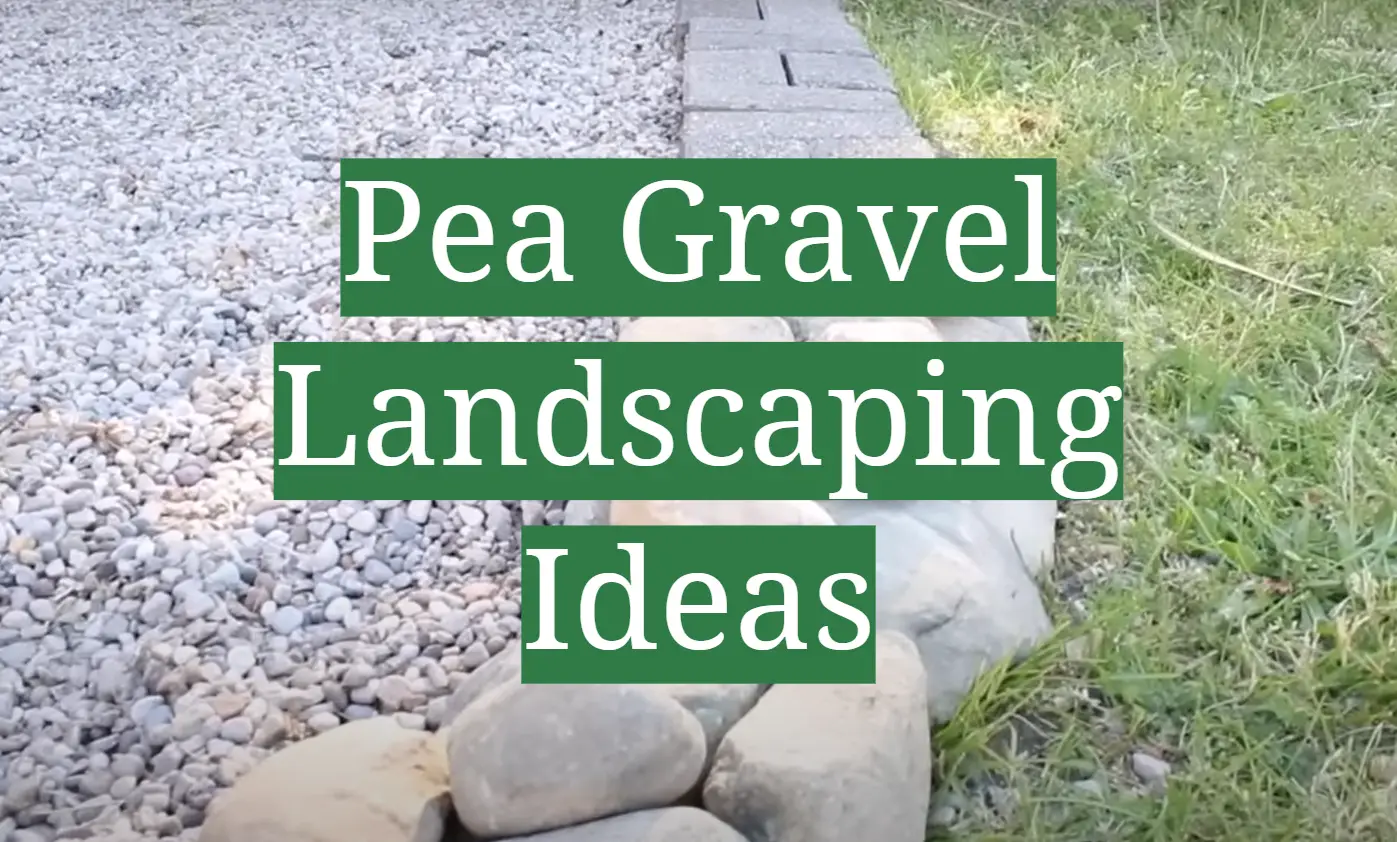




Leave a Reply
View Comments